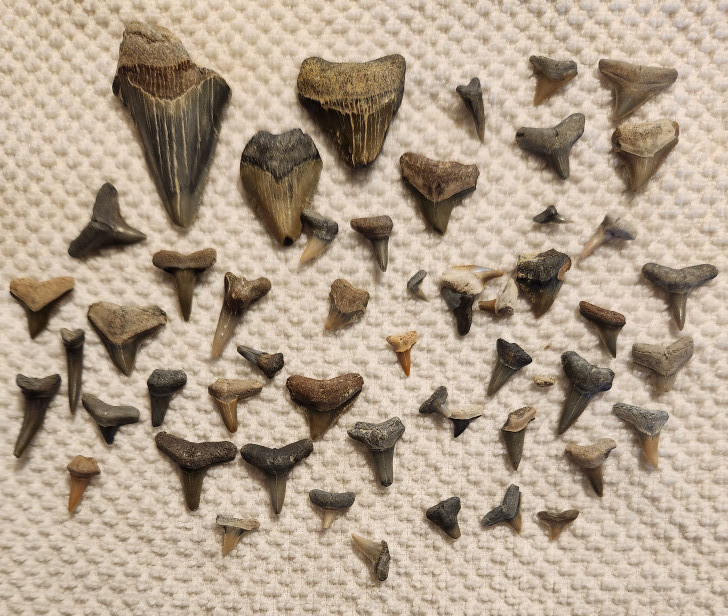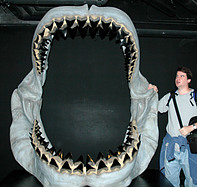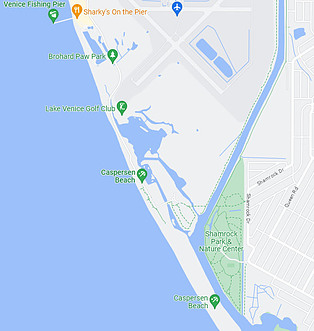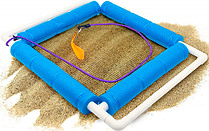Journey into Florida’s Fossil Wonderland: Unveiling the Secrets of Shark Teeth

Walking along the beautiful beaches of Florida can be a relaxing escape from the hustle and bustle of everyday life. But instead of just watching the waves crash against the sand, you could find yourself diving deep into an ancient fossil treasure hunt! Have you ever wanted to go on a real-life archaeology mission in search of shark teeth? With some helpful tips and tricks about where to look, what tools to use, and how to identify them– we have all that you need right here so join us as we take a journey into Florida’s fossil wonderland!
The allure of Florida’s fossil sites
Florida is known for its beautiful beaches, stunning sunsets, and breathtaking wildlife. However, beyond the sunshine and sandy shores, lies a hidden gem that many travelers aren’t aware of – fossil sites. These ancient remnants of prehistoric creatures offer a glimpse into the history of our planet and are a must-visit for anyone interested in paleontology. From the famous Peace River in central Florida to the beaches of Venice, these fossil sites offer a plethora of opportunities to discover the secrets of the past. Whether you’re a seasoned fossil hunter or a curious traveler, exploring Florida’s fossil sites is an experience you’ll never forget.
Understanding Shark Teeth
Sharks have some of the most impressive teeth in the animal kingdom. Despite their often fearsome reputation, these sharp, powerful teeth are actually an essential tool for these fascinating creatures. Understanding the structure and function of shark teeth can provide valuable insight into their behavior and biology. For example, the different shapes and sizes of shark teeth can help us understand what they eat and how they catch their prey. But there is much more to learn about these amazing creatures and their teeth, and studying them can provide important information about the marine ecosystem as a whole.
Shark teeth basics
Shark teeth are fascinating structures that have been the subject of curiosity and research for centuries. These teeth are unique because they are constantly breaking and being replaced throughout a shark’s life. They are incredibly sharp and can be used for hunting, defense, and even as tools for manipulating prey. One of the most interesting things about shark teeth is that they come in a wide variety of shapes and sizes. Some are flat and wide for crushing shellfish, while others are long and pointed for piercing flesh. The study of these teeth can tell us a lot about the behavior and diet of different species of sharks, which makes them a valuable resource for scientists and enthusiasts alike.
Why Florida is a Haven for shark teeth
It’s because Florida’s location and geology make it an ideal spot for finding the remnants of some deep sea beasts, like megalodon and great white sharks. These prehistoric predators stalked the depths of Florida’s ancient oceans millions of years ago, leaving behind teeth that are coveted by collectors around the world.
Unveiling the Mighty Megalodon

The Megalodon is a creature of sea legend, known for its sheer size and toothy grin. Despite being extinct for millions of years, this shark continues to capture the imaginations of scientists and enthusiasts alike. A true behemoth of the prehistoric world, the megalodon is thought to have been up to three times larger than the great white shark, which is already a formidable apex predator. From its jagged teeth to its powerful fins, every inch of the megalodon exudes strength and skill in the water.
Introducing the Megalodon
The Megalodon, also known as the biggest shark that ever lived, is the stuff of legends. This massive predator ruled the oceans some 3.6 million years ago, and its size is nothing short of awesome. Estimates suggest that the Megalodon could grow to be up to 60 feet long, making it larger than most modern-day whales. It’s hard to even fathom the sheer size and power of this ancient beast. It is considered the largest predatory fish to have ever existed, with a jaw that could open up to three meters wide. Fascinatingly, its teeth could grow up to seven inches long, with around 276 teeth lining its massive jaws. This fearsome creature could weigh up to 50 tons, making it almost three times heavier than a Tyrannosaurus Rex.
oceans some 3.6 million years ago, and its size is nothing short of awesome. Estimates suggest that the Megalodon could grow to be up to 60 feet long, making it larger than most modern-day whales. It’s hard to even fathom the sheer size and power of this ancient beast. It is considered the largest predatory fish to have ever existed, with a jaw that could open up to three meters wide. Fascinatingly, its teeth could grow up to seven inches long, with around 276 teeth lining its massive jaws. This fearsome creature could weigh up to 50 tons, making it almost three times heavier than a Tyrannosaurus Rex.
Exploring Florida’s Fossil Hotspots
Florida is a veritable treasure trove of prehistoric relics and fossils, attracting scientists and history buffs from all over the world. The Sunshine State’s unique geology and rich diversity make it a hotbed for ancient discoveries, with countless hotspots just waiting to be explored. From the phosphate mines in Polk County to the Peace River, there are plenty of places to dig up the past and uncover some truly fascinating finds.
Peace River
The Peace River is a treasure trove for fossil enthusiasts and nature lovers alike. Spanning over 100 miles, this river in Florida is known for its abundance of prehistoric shark teeth, with estimates ranging from 50,000 to 100,000 teeth per square mile. Imagine strolling along the peaceful river banks, feeling the cool breeze on your face while scouring the sandy shores for teeth belonging to extinct Megalodon and other ancient shark species. It’s a unique experience that offers a glimpse into the history of our planet and the fascinating creatures that roamed the oceans millions of years ago. Whether you’re a seasoned fossil hunter or a curious traveler, this location will leave you in awe of nature’s masterpieces.
Venice Beach
Prime location for fossil enthusiasts
If you’re a fan of fossils, then you need to make your way down to Venice Beach. Not only is it a popular spot for people-watching and soaking up the sun, but it’s also a prime location for finding some incredible fossils. You never know what you might stumble upon – from ancient shark teeth to prehistoric shells, there’s something for everyone. So grab your sunscreen, shovel, and a shifter, and get ready to explore the fascinating world of fossils at Venice Beach. It’s a unique and exciting way to spend a day by the sea.
Expert Tips for Successful Fossil Hunting
Fossil hunting is an exciting activity for all ages. Whether you are a professional paleontologist or a casual collector, there’s nothing quite like the thrill of discovering a prehistoric treasure. To increase your chances of success, it’s important to keep a few expert tips in mind. First, do your research and scout out locations that are known to be rich in fossils. Next, bring the right tools and equipment, to help you extract and identify fossils. Remember to always respect the environment and follow any local regulations. With these tips in mind, you’ll be on your way to a successful fossil-hunting adventure.
Essential tools and equipment

Finding shark teeth can be an exciting and rewarding hobby, but you’ll need the right tools to make the most of your search. First and foremost, invest in a sturdy mesh sieve to sift through sand and sediment. A shovel and sifter combo will save you the hassle of bending down and getting up repeatedly, making your search more efficient. Additional tools to consider include a sand scoop for tougher surfaces, a serrated knife for cleaning teeth, a magnifying glass to get a closer look at your finds, and a mesh bag to keep your treasures. With the right tools and plenty of patience, you’ll be on your way to a jaw-some shark teeth collection in no time.
tools to make the most of your search. First and foremost, invest in a sturdy mesh sieve to sift through sand and sediment. A shovel and sifter combo will save you the hassle of bending down and getting up repeatedly, making your search more efficient. Additional tools to consider include a sand scoop for tougher surfaces, a serrated knife for cleaning teeth, a magnifying glass to get a closer look at your finds, and a mesh bag to keep your treasures. With the right tools and plenty of patience, you’ll be on your way to a jaw-some shark teeth collection in no time.
Preserving and Identifying Your Shark Teeth Finds
When it comes to finding shark teeth, it’s important to know how to preserve and identify them properly. One way to preserve your shark teeth is by cleaning them with mild soap and water. Be sure to let them dry completely before storing them in a container. It’s also a good idea to label your findings with a location and date to help with identification, identifying your shark teeth can be a fun and challenging process. There are a variety of online resources, field guides, and even apps available to help with this task. With a little bit of research, you’ll be able to tell a bull shark tooth from a mako shark tooth in no time!
Identifying different shark tooth species
Sharks have numerous species, each with unique teeth structures that vary in shape, size, and placement. Identifying these shark tooth species is essential for understanding their behavior, evolution, and ecology. For instance, the Great White Shark has triangular teeth that help it grip and tear prey, while the Tiger Shark has serrated teeth that allow it to crush shells and bones. Scientists use several techniques to identify these different shark tooth species, from analyzing their morphology and texture to their chemical composition and DNA. By studying shark teeth, researchers can unravel the mysteries of their anatomy, biology, and evolutionary history.
Responsible fossil collecting practices
As humans, we have a natural fascination with the past and the secrets it holds. One way to uncover these secrets and gain a glimpse into ancient history is through fossil collecting. However, it’s important to practice responsible fossil collecting practices to avoid damaging or destroying important scientific evidence. This includes obtaining proper permits, using the correct tools, and seeking professional advice when necessary. By preserving fossils through responsible collecting practices, we can continue to learn and uncover more about our planet’s rich history.
Frequently Asked Questions (FAQs)
Q. What is the best time of year for shark tooth hunting in Florida?
A. It’s always a good idea to plan your trip during the late fall and winter months, when the beaches are less crowded and the tides are more favorable, and river levels are lower.
Q. Are there any legal restrictions on fossil collecting in Florida?
A. Florida is a state that is well-known for its many collections and abundance of fossils from various periods of geological history. However, as with any type of collecting, there are regulations in place to protect both the fossils and the environment. In Florida, there are legal restrictions on fossil collecting and you will need a permit to do so. Shark teeth, invertebrates, and plant fossils do not require a permit.
Q. How can I differentiate between a modern and fossilized shark tooth?
A. Modern shark teeth are typically white, off-white, or grayish. Fossilized shark teeth, on the other hand, can vary in color depending on the minerals present in the sediment where they fossilized.
Q. Are there any other fossils I might find while searching for fossil shark teeth?
A. While searching for shark teeth, there is always the possibility of stumbling upon some other fascinating fossils. One such fossil that can often be found in the same sediment deposits as shark teeth is that of the ray. Additionally, if you’re lucky, you may even find the fossilized remains of other sea creatures like sea turtles, crocodiles, and even the ancient, giant megalodon shark.
Q. What should I do if I discover a significant fossil?
A. Discovering a significant fossil can be an exhilarating experience, but it’s important to know what to do next. Firstly, take caution and do not touch or move the fossil as it may be fragile and easily damaged. Take note of the location and surroundings of the fossil, as the context of its discovery is just as important as the fossil itself. It’s best to contact a local museum or university with a paleontology department, as they will be equipped to handle and preserve the fossil properly.
Reflecting on the wonder of Florida’s fossil sites
Florida is a land of wonder, from its stunning beaches to its sprawling cities, and even to its prehistoric history. The fossil sites scattered across the state offer a glimpse into a bygone era when sabor-toothed cats roamed the land and giant sharks prowled the ancient seas. These sites are an abundance of information, allowing researchers and amateur enthusiasts alike to study and appreciate the ancient creatures that once walked (or swam) on Florida’s soil. There’s something truly special about getting up close and personal with such incredible relics of the past, and it’s easy to get lost in the wonder and awe of it all. So the next time you’re in Florida, take some time to visit one of these fossil sites and experience the wonder for yourself!


The teeth of sharks are so, amazing when you look at the design and how the teeth are positioned is a clear indication they were made for cutting through meat. One shark that I found to be interesting however is the megalodon shark that said once lived. Could you imagine the teeth of these sharks because they were said to be giant predators that ruled the seas?
Thanks for the comment! The Meg was truly an incredible shark that grew to about 60 feet and the largest tooth found was about 6 inches long.